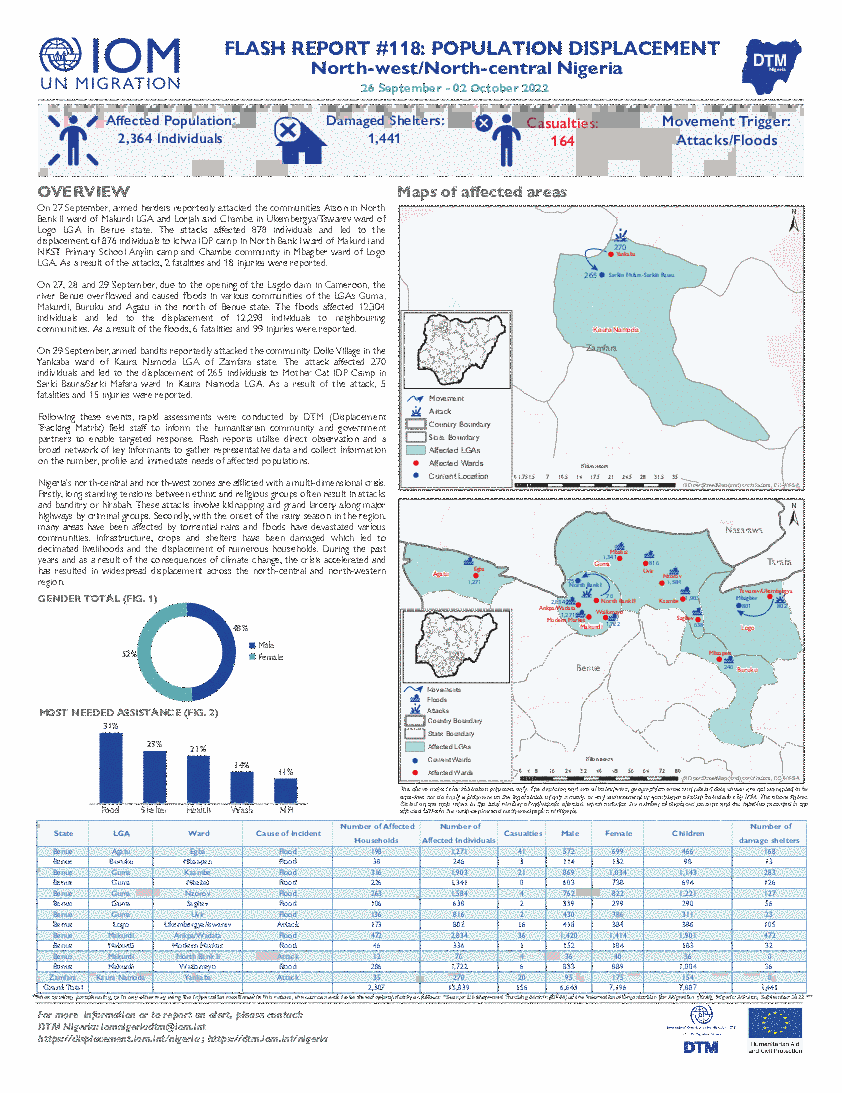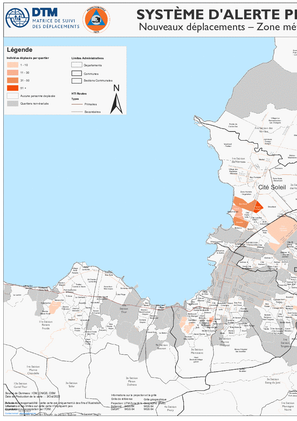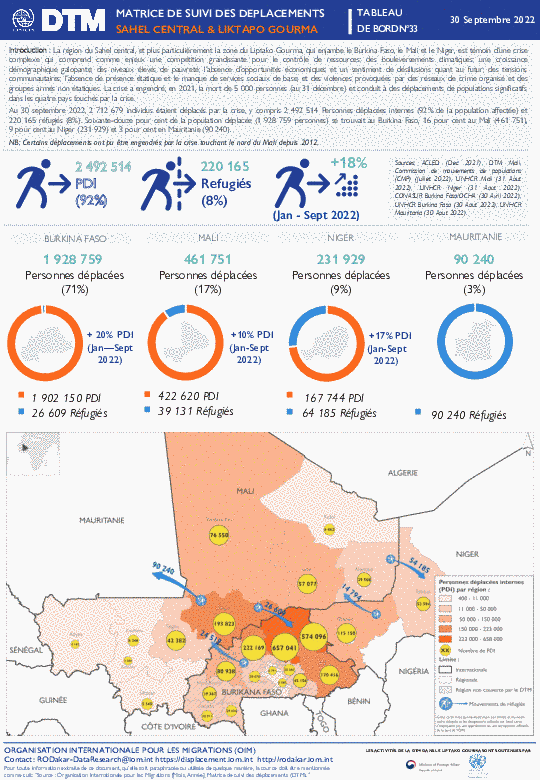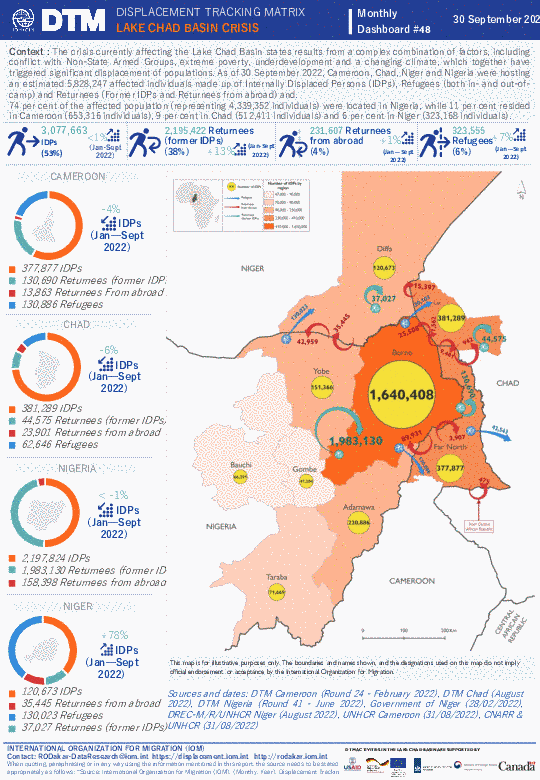-
Countries
-
Data and Analysis
-
Special Focus
-
Crisis Responses

Contact
DTM Nigeria, AllUsersInDTMNigeria@iom.int
Language
English
Location
Nigeria
Period Covered
Sep 26 2022
Oct 02 2022
Activity
- Mobility Tracking
- Event Tracking
On 27 September, armed herders reportedly attacked the communities Atson in North Bank II ward of Makurdi LGA and Lorjah and Chambe in Ukembergya/Tswarev ward of Logo LGA in Benue state. The attacks affected 878 individuals and led to the displacement of 876 individuals to Ichwa IDP camp in North Bank I ward of Makurdi and NKST Primary School Anyiin camp and Chambe community in Mbagber ward of Logo LGA. As a result of the attacks, 2 fatalities and 18 injuries were reported.
On 27, 28 and 29 September, due to the opening of the Lagdo dam in Cameroon, the river Benue overflowed and caused floods in various communities of the LGAs Guma, Makurdi, Buruku and Agatu in the north of Benue state. The floods affected 12,304 individuals and led to the displacement of 12,298 individuals to neighbouring communities. As a result of the floods, 6 fatalities and 99 injuries were reported.
On 29 September, armed bandits reportedly attacked the community Dolle Village in the Yankaba ward of Kaura Namoda LGA of Zamfara state. The attack affected 270 individuals and led to the displacement of 265 individuals to Mother Cat IDP Camp in Sarki Baura/Sarki Mafara ward in Kaura Namoda LGA. As a result of the attack, 5 fatalities and 15 injuries were reported.
Carte des Nouvelles arrivées des PDI dans la zone métropolitaine de Port-au-Prince, du 10 - 16 septembre 2022.
Carte des nouveaux déplacements – Zone métropolitaine de Port-au-Prince – 10 - 16 septembre 2022.
La région du Sahel central, et plus particulièrement la zone du Liptako Gourma, qui enjambe le Burkina Faso, le Mali et le Niger, est témoin d’une crise complexe qui comprend comme enjeux une compétition grandissante pour le contrôle de ressources; des bouleversements climatiques; une croissance démographique galopante; des niveaux élevés de pauvreté; l’absence d’opportunités économiques et un sentiment de désillusions quant au futur; des tensions communautaires; l’absence de présence étatique et le manque de services sociaux de base; et des violences provoquées par des réseaux de crime organisé et des groupes armés non étatiques. La crise a engendré, en 2021, la mort de 5 000 personnes (au 31 décembre) et conduit à des déplacements de populations significatifs dans les quatre pays touchés par la crise.
Au 30 septembre 2022, 2 712 679 individus étaient déplacés par la crise, y compris 2 492 514 Personnes déplacées internes (92% de la population affectée) et 220 165 réfugiés (8%). Soixante-douze pour cent de la population déplacée (1 928 759 personnes) se trouvait au Burkina Faso, 16 pour cent au Mali (461 751), 9 pour cent au Niger (231 929) et 3 pour cent en Mauritanie (90 240).
NB: Certains déplacements ont pu être engendrés par la crise touchant le nord du Mali depuis 2012.
The Central Sahel area, and in particular the Liptako Gourma region, which borders Burkina Faso, Mali and Niger, is affected by a complex crisis involving growing competition over dwindling resources; climatic variability; demographic pressure; high levels of poverty; disaffection and a lack of livelihood opportunities; communal tensions; the absence of state institutions and basic services; and violence related to organized crime and Non-State Armed Groups. The crisis has led to the death of an estimated 5,000 people in 2021 (as of 31 December) and triggered significant displacement of populations in the four affected countries.
As of 30 September 2022, 2,712,679 individuals have been displaced, including 2,492,514 Internally Displaced Persons (92% of the displaced population) and 220,165 Refugees (8% of the displaced population). Seventy-two per cent of the displaced population (1,928,759 individuals) were located in Burkina Faso, while 16 per cent resided in Mali (461,751 individuals), 9 per cent in Niger (231,929 individuals) and 3 per cent in Mauritania (90,240 individuals).
NB: Displacements may also be linked to the crisis affecting Northern Mali since 2012.
La crise dans le Bassin du lac Tchad est le résultat d’une combinaison complexe d’une multitude de facteurs, y compris un conflit armé impliquant des groupes armés non étatiques, des niveaux extrêmes de pauvreté, un sous-développement persistant, et des bouleversements climatiques, qui ont conduit à des déplacements de populations importants. Au 30 septembre 2022, le Cameroun, le Tchad, le Nigeria et le Niger accueillaient 5 828 247 individus affectés par la crise, dont des Personnes déplacées internes (PDI), des réfugiés et des retournés (anciennes PDI et retournés de l’étranger). 74 pour cent d’entre eux (soit 4 339 352 personnes) se trouvaient au Nigéria, 11 pour cent au Cameroun (653 316 personnes), 9 pour cent au Tchad (512 411 personnes) et 6 pour cent au Niger (323 168 personnes).
The crisis currently affecting the Lake Chad Basin states results from a complex combination of factors, including conflict with Non-State Armed Groups, extreme poverty, underdevelopment and a changing climate, which together have triggered significant displacement of populations. As of 30 September 2022, Cameroon, Chad, Niger and Nigeria were hosting an estimated 5,828,247 affected individuals made up of Internally Displaced Persons (IDPs), Refugees (both in- and out-of-camp) and Returnees (Former IDPs and Returnees from abroad) and.
74 per cent of the affected population (representing 4,339,352 individuals) were located in Nigeria, while 11 per cent resided in Cameroon (653,316 individuals), 9 per cent in Chad (512,411 individuals) and 6 per cent in Niger (323,168 individuals).
La République centrafricaine (RCA) a été témoin de volatilité incessante depuis deux décennies. La dernière crise atteignant le pays a débuté en 2012, suite à une prise du pouvoir accouchée dans la violence, et a depuis évolué en un état d’insécurité et de fragilité permanentes, découlant d’une crise complexe de long-terme qui s’est étendue dans les pays voisins. La crise a conduit au décès de 506 personnes en 2022 (au 30 avril) et a déclenché des déplacements massifs de populations dans les sept pays touchés par la crise. Cette dernière est caractérisée par des rivalités pour le pouvoir parmi les élites du pays, l’absence d’institutions étatiques et d’investissement d’argent public, des tensions inter-ethniques et inter-religieuses et la lutte pour le contrôle de ressources.
Au 30 septembre 2022, 3 722 410 individus étaient déplacés, dont 654 688 Personnes déplacées internes (18% de la population déplacées), 1 880 785 Retournés (anciennes PDI) (51%), 446 625 Retournés de l’étranger (12%) et 740 312 Réfugiés dans les pays limitrophes (20%). En RCA, les Retournés anciennes PDI représentent la plus grande population affectée (63%), tandis que les PDI représentent 22 pour cent de la population atteinte dans le pays et les Retournés de l’étranger 15 pour cent de la population déplacée présente dans le pays. Les réfugiés centrafricains résident principalement au Cameroun (347 937 individus, soit 47% des réfugiés), la République démocratique du Congo (211 953 individus, soit 29% des réfugiés) et au Tchad (124 488 individus, soit 17% des réfugiés).
The Central African Republic, which has experienced continuous volatility for the past two decades, has been riddled by a crisis which ignited in 2012 with a violent takeover of power and has developed into a complex protracted state of permanent insecurity and fragility which has spilled over into neighbouring countries. The crisis has led to the death of an estimated 506 people in 2022 (as of 30 April) and triggered significant displacement of populations in the seven affected countries. The crisis is characterized by power struggles amongst elites, the absence of state institutions and public investment, religious and ethnic tensions and disputes for the control of key resources.
As of 30 September 2022, 3,722,410 individuals were displaced, including 654,688 Internally Displaced Persons (18% of the displaced population), 1,880,785 Returnees (former IDPs) (51%), 446,625 Returnees from abroad (12%) and 740,312 Refugees in neighbouring countries (20%). In the Central African Republic, the largest displaced population consists of Former IDP Returnees (63%), while IDPs represent 22 per cent of the displaced population present in the country and Returnees from abroad represent 15 per cent of in-country displaced people. Refugees from the Central African Republic are primarily hosted by Cameroon (347,937 individuals, or 47% of refugees), the Democratic Republic of the Congo (211,953 individuals, or 29% of refugees) and Chad (124,488 individuals, or 17% of refugees).

Contact
DTM Sudan; dtmsudan@iom.int
Language
English
Location
Sudan
Period Covered
Sep 05 2022
Sep 18 2022
Activity
- Mobility Tracking
- Event Tracking
The DTM Emergency Event Tracking (EET) is deployed to track sudden displacement and population movements, provide more frequent updates on the scale of displacement, and quantify the affected population when needed. As a subcomponent of the new Mobility Tracking methodology in Sudan (Round Four), and activated on a need basis, EET utilises a broad network of key informants to capture best estimates of the affected population presence per location – a useful tool for humanitarian response planning and design.








